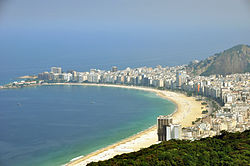Copacabana, Rio de Janeiro
22°58′1.32″S 43°10′50.51″W / 22.9670333°S 43.1806972°W

Copacabana (Portuguese pronunciation: [kopakaˈbɐ̃nɐ]) is a borough located in the southern zone of the city Rio de Janeiro, known for its 4 km beach which is one of the most famous in the world.
The district was originally called Sacopenapã until the mid-18th century. It was renamed after the construction of a chapel holding a replica of the Virgen de Copacabana, the patron saint of Bolivia. It was incorporated into the city on July 6, 1892.
Copacabana begins at Princesa Isabel Avenue and ends at Posto Seis (lifeguard watchtower Six). Beyond Copacabana, there are two small beaches, one inside Fort Copacabana and other, right after it: Diabo Beach. Arpoador beach, where surfers used to go after its perfect waves, comes in the sequence, followed by the famous borough of Ipanema.
According to Riotur, the Tourism Secretariat of Rio de Janeiro, there are 63 hotels and 10 hostels in Copacabana.[1]
Copacabana Beach


Copacabana beach stretches from Posto Dois (lifeguard watchtower Two) to Posto Seis (lifeguard watchtower Six). Leme is at Posto Um (lifeguard watchtower One). There are historic forts at both ends of Copacabana beach; Fort Copacabana, built in 1914, is at the south end by Posto Seis and Fort Duque de Caxias, built in 1779, at the north end. One curiosity is that the lifeguard watchtower of Posto Seis never existed.[2]
Hotels, restaurants, bars, night clubs and residential buildings dot the promenade.
Copacabana Beach plays host to millions of revellers during the annual New Year's Eve celebrations and, in most years, has been the official venue of the FIFA Beach Soccer World Cup.
Copacabana promenade
The Copacabana promenade is a pavement landscape in large scale (4 kilometres long). It was completed in 1970 and has used a black and white Portuguese pavement design since its origin in the 1930s: a geometric wave. The Copacabana promenade was designed by Roberto Burle Marx.
Living standard
Copacabana has the 11th highest Human Development Index in Rio, the 2000 census put the HDI of Copacabana at 0.902.[3]

The borough
According to the IBGE, 160,000 people live in Copacabana and 44,000 or 27.5% of them are 60 years old or older.[4][5] Copacabana covers an area of 7.84 km²[citation needed] which gives the borough a population density of 20,400 people per km².
Residential buildings eleven to thirteen stories high built right next to each other dominate the borough. Houses and two-story buildings are rare.
Transportation
More than 40 different bus routes serve Copacabana,[6] as do four subway Metro stations: Cantagalo, Siqueira Campos, Cardeal Arcoverde and General Osório
Three major arteries parallel to each other cut across the entire borough: Atlantic Avenue, which is a 6 lane 4 km avenue by the beachside, Nossa Senhora de Copacabana Avenue and Barata Ribeiro/Raul Pompéia Street both of which are 4 lanes and 3.5 km in length. Barata Ribeiro Street changes its name to Raúl Pompéia Street after the Sá Freire Alvim Tunnel. Twenty-four streets intersect all three major arteries, and seven other streets intersect some of the three, but not all.
Notable events

- On 26 April 1949, RMS Magdalena broke in two as she was being towed into Rio de Janeiro harbour. Much of her cargo of oranges was washed up upon the beach.
- On December 31, 1994, the New Year's Eve celebrations featured a Rod Stewart concert, which featured 3.5 million, making it the largest concert crowd ever.[7] More recently, the beach has been a site for huge free concerts unrelated to the year-end festivities. On March 21, 2005, Lenny Kravitz performed there in front of 300,000 people, on a Monday night. On February 18, 2006, a Saturday, The Rolling Stones surpassed that mark by far, attracting over 1.5 million people to the beach.
- On July 7, 2007, the beach hosted the Brazilian leg of the Live Earth concerts, which attracted 400,000 people. As the headliner, Lenny Kravitz got to play the venue a second time, with Jorge Benjor, Macy Gray, O Rappa and Pharrell as the main opening acts, on October 2, 2009, 100,000 people filled the beach for a huge beach party as the IOC announced Rio would be hosting the 2016 Olympics. 11 of the 15 FIFA Beach Soccer World Cups have taken place here.
Elton John had 2 concerts cancelled at the famous beach.The first in 2006 (New Year Party) and the second in 2007 (Red Piano Free Concert)
See also
References
- ^ Riotur
- ^ FUNCEB - Fundação Cultural Exército Brasileiro
- ^ Compilação de dados, informações e fatos sobre Copacabana - Copacabana.COM
- ^ jsessionid=D87126B13F258E820EA8A71A891194B3?id=8449 SPL.camera.rj.gov.br
- ^ Veja Rio on-line
- ^ Rio Ônibus
- ^ "Rolling Stones hold giant Rio gig". London: BBC News. 2006-02-19. Retrieved 2009-01-21.
